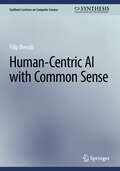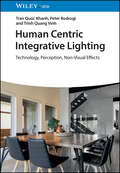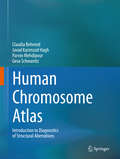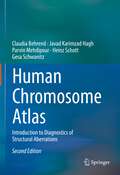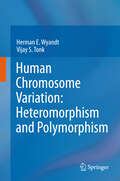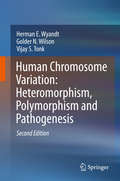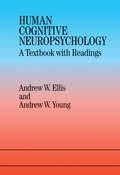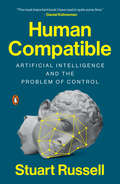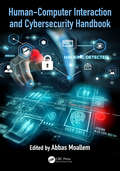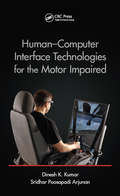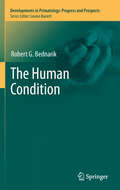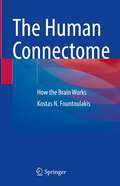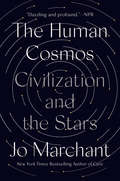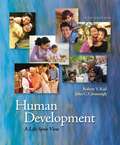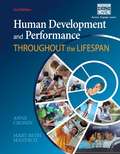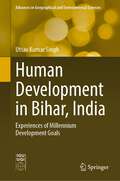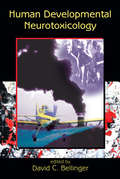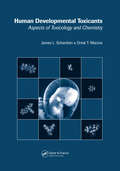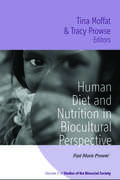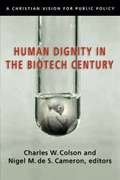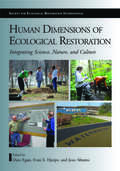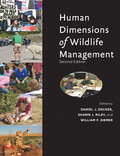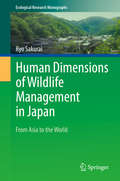- Table View
- List View
Human-Centric AI with Common Sense (Synthesis Lectures on Computer Science)
by Filip IlievskiThis book enables readers to understand the challenges and opportunities of developing human-centered AI with commonsense reasoning abilities. Despite apparent accuracy improvements brought by large neural models across task benchmarks, common sense is still lacking. The lack of common sense affects many tasks, including story understanding, decision-making, and question answering. Commonsense knowledge and reasoning have long been considered the “black matter” of AI, raising concerns about the trustworthiness and applicability of AI methods in both autonomous and hybrid applications. This book describes how to design a more robust, collaborative, explainable, and responsible AI through incorporating neuro-symbolic commonsense reasoning. In addition, the book provides examples of how these properties of AI can facilitate a wide range of social-good applications in digital democracy, traffic monitoring, education, and robotics. What makes commonsense reasoning such a unique and impactful challenge? What can we learn from cognitive research when designing and developing AI systems? How can we approach building responsible, robust, collaborative, and explainable AI with common sense? And finally, what is the impact of this work on human-AI teaming? This book provides an accessible introduction and exploration of these topics.
Human Centric Integrative Lighting: Technology, Perception, Non-Visual Effects
by Tran Quoc Khanh Peter Bodrogi Trinh Quang VinhHuman Centric Integrative Lighting Detailed presentation of the technical and non-technical aspects of modern lighting and its effect on humans Human Centric Integrative Lighting provides a highly comprehensive overview of the subject, also referred to as human-centered indoor lighting technology; taking a practice-oriented approach, scientific findings in the field are condensed into models that can be directly used by developers. Written by leading scientists in the field of lighting technology, Human Centric Integrative Lighting includes detailed information on: Fundamentals of lighting technology as it interacts with human perception and the current state of interior lighting today Basic principles of human centric integrative lighting and its various aspects, such as visual performance, color quality, emotional impact, and correlation of relevant parameters Comprehensive lighting quality models and subsequently derived recommendations for the practical implementation of concepts Relevant research findings from journals, patent specifications, and standards to provide a unified outlook on the field Providing a comprehensive overview of the current state of development in the field, Human Centric Integrative Lighting discusses validated physiological and psychological perceptual models on which manufacturers of lighting products and suppliers of lighting technology solutions can base key design and development decisions. lighting products; lighting technology solutions; lighting design; lighting development; human-centered indoor lighting technology; lighting color quality; lighting principles; lighting emotional impact; lighting quality; lighting research
Human Chromosome Atlas
by Claudia Behrend Javad Karimzad Hagh Parvin Mehdipour Gesa SchwanitzThis atlas presents the results of cases of structural chromosome aberrations based on the currently available methods of analysis for different types of abnormality. It particularly focuses on which spectrum should be chosen when combining the different techniques to achieve the best method of diagnosis in individual cases, for example direct preparation of cells and mitoses, short or long-time cell culture, fluorescence in situ hybridization (FISH), analysis of interphases, microarray or DNA sequencing. Generally it has to be taken into account, that the development of new and improved investigation methods is forthcoming. Thus, by improvement of diagnostic possibilities new fields of investigation arise, and special groups of patients with cytogenetic analyses can be re-analysed under new research questions.
Human Chromosome Atlas: Introduction to Diagnostics of Structural Aberrations
by Claudia Behrend Javad Karimzad Hagh Parvin Mehdipour Heinz Schott Gesa SchwanitzNow in its second edition, this atlas serves as an easy-to-use diagnostic guide for the analysis of the human karyotype. Split in four parts, it starts with a comprehensive introduction covering the molecular cytogenetic basics, the role of ethic committees and international quality control in the field of diagnostics. The main parts II and III show the spectrum of different types of chromosomal abnormalities by a combination of karyogram and ideogram. They compare the significance of different banding techniques, give the karyotype formula and describe morphological peculiarities of each case presented. The final part provides a detailed description of non-coding DNA variants and focuses on potential problems in the detection of aberrations. It also mentions necessary additional investigations and peculiarities to be considered when counselling carriers of a chromosomal aberration or their relatives. Given its comprehensive scope and practical approach, this atlas is an indispensable resource for researchers, clinicians and practitioners working in the field of cytogenetics and clinical genetics.
Human Chromosome Variation: Heteromorphism and Polymorphism
by Herman E. Wyandt Vijay S. TonkHuman Chromosome Variation: Heteromorphism and Polymorphism was formerly printed under the title "Atlas of Human Chromosome Heteromorphism". The Atlas has become a standard reference book in most cytogenetic laboratories and is cited as a significant reference in ISCN 2009. This revised version has updated and retained the most useful pictorial sections of the first edition, including the comprehensive review of normal and "not-so-normal" variations of the human karyotype with summaries and extensive reference lists organized by chromosome number. This updated edition features concise background information on chromosome methods and applications, essential information on heteromorphism frequencies in normal and clinical populations as well as new listing and discussions of euchromatic, subtelomeric and FISH variants. The addition of two new sections make this an even more valuable reference than before. A section on common and rare fragile sites includes a short historical discussion, definitions and an extensive table of officially recognized sites that includes the HUGO name, chromosomal location, methods of induction, genes and references to the most recent molecular characterization. A new section on array CGH discusses the clinical challenge of interpreting copy number variations (CNVs) revealed by this newest technology, gives examples of various levels of interpretation and lists the several most common websites used in this interpretation.
Human Chromosome Variation: Heteromorphism, Polymorphism and Pathogenesis
by Herman E. Wyandt Golder N. Wilson Vijay S. TonkThis new edition now titled "Human Chromosome Variation: Heteromorphism, Polymorphism and Pathogenesis" provides the reader with an up-to-date overview of microarrays, fragile sites, copy number variations and whole genome sequencing. Greatly expanding the discussion of microarray analysis in the previous edition of the book, are new chapters on microarray and genomic analysis, plus comprehensive tables on the subtle microdeletions and microduplications that are found on each chromosome, including 235 recurring copy number variants that are associated with well-established or emerging chromosomal syndromes. The current edition features concise information on cytogenetic methods and applications, extending these discussions to DNA analysis and genome sequencing. Sections on euchromatin, heterochromatin, FISH pattern, fragile site, copy number, and DNA sequence variation are integrated with actual clinical examples from cytogenetic laboratories and from clinical practice. The principles that allow for the distinction between benign chromosome / DNA variation and pathogenic heteromorphisms / polymorphisms are discussed and include references to the latest organizational guidelines and genomic or population databases. The two previous incarnations of this book: the 'Atlas of Human Chromosome Heteromorphism', and 'Human Chromosome Variation: Heteromorphism and Polymorphism' have been standard reference works in most cytogenetic laboratories, used by laboratory directors and clinicians all around the world. While widely used sections from the previous edition on cytogenetic technologies and heteromorphisms are retained intact the present volume adds extensive material on copy number variations (polymorphisms detected by microarray analysis), fragile sites in disease and cancer, and practical views on interpreting emerging technologies, including whole exome sequencing. This book should be of interest to clinicians, technicians and students who are or will be exposed to DNA and/or chromosome analysis and the data derived from these continuously developing techniques. This fully updated book volume will bring the reader up to speed on the latest technologies, their applications, benefits and drawbacks and as such, is a must read for anyone with an interest in DNA and chromosome analysis and the distinction between benign variation and pathogenic mistakes.
Human Cloning
by Kerry Lynn MacintoshMany people think human reproductive cloning should be a crime-some states have even outlawed it and Congress is working to enact a national ban. However, if reproductive cloning soon becomes a reality, it will be impossible to prevent infertile couples and others from choosing the technology, even if they have to break the law. While most books on cloning cover the advantages and disadvantages of cloning technology, Illegal Beings describes the pros and cons of laws against human reproductive cloning. Kerry Lynn Macintosh, an attorney with expertise in the area of law and technology, argues that the most common objections to cloning are false or exaggerated, inspiring laws that stigmatize human clones as subhuman and unworthy of existence. She applies the same reasoning that was used to invalidate racial segregation to show how anti-cloning laws, by reinforcing negative stereotypes, deprive human clones of their equal protection rights under the law. Her book creates a new topic within constitutional law: existential segregation, or the practice of discriminating by preventing the existence of a disfavored group or class. This comprehensive and novel work looks at how anti-cloning laws will hurt human clones in a fresh perspective on this controversial subject. Kerry Lynn Macintosh is a member of the Law and Technology faculty at Santa Clara University School of Law. She is the author of papers, articles, and book chapters on the law and technology and has contributed to the Harvard Journal of Law and Technology, Boston University Journal of Science and Technology Law, and Berkeley Technology Law Journal.
Human Cognitive Neuropsychology: A Textbook With Readings
by Andrew W. Ellis Andrew W. YoungThis textbook augments the first edition through the inclusion of a set of reseach and review papers selected by the authors to supplement the contents of each chapter by providing a discussion of research issues and detailed investigation of individual cases. One or two papers supplement each chapter. A short introduction to each set makes clear the nature of their contribution and how they relate to each chapter's contents. Some of the papers are short reviews of theoretical contributions; others are case studies in the tradition of cognitive neuropsychology. At least three of the main trends discernible in cognitive neuropsychology in the 1990s are represented in the chosen papers. The first is the use of connectionist models to simulate patterns of impairment in brain-injured patients. The second is the growing convergence between cognitive neuropsychology and neuroscience: cognitive neuropsychologists are becoming increasingly interested in the brain processes that underlie the preserved and damaged psychological processes they study. The third trend is the involvement of cognitive neuropsychologists in work on therapy and rehabilitation.
Human Compatible: Artificial Intelligence and the Problem of Control
by Stuart Russell"The most important book I have read in quite some time" (Daniel Kahneman); "A must-read" (Max Tegmark); "The book we've all been waiting for" (Sam Harris)A leading artificial intelligence researcher lays out a new approach to AI that will enable us to coexist successfully with increasingly intelligent machinesLonglisted for the 2019 Financial Times/McKinsey Business Book of the Year AwardIn the popular imagination, superhuman artificial intelligence is an approaching tidal wave that threatens not just jobs and human relationships, but civilization itself. Conflict between humans and machines is seen as inevitable and its outcome all too predictable. In this groundbreaking book, distinguished AI researcher Stuart Russell argues that this scenario can be avoided, but only if we rethink AI from the ground up. Russell begins by exploring the idea of intelligence in humans and in machines. He describes the near-term benefits we can expect, from intelligent personal assistants to vastly accelerated scientific research, and outlines the AI breakthroughs that still have to happen before we reach superhuman AI. He also spells out the ways humans are already finding to misuse AI, from lethal autonomous weapons to viral sabotage. If the predicted breakthroughs occur and superhuman AI emerges, we will have created entities far more powerful than ourselves. How can we ensure they never, ever, have power over us? Russell suggests that we can rebuild AI on a new foundation, according to which machines are designed to be inherently uncertain about the human preferences they are required to satisfy. Such machines would be humble, altruistic, and committed to pursue our objectives, not theirs. This new foundation would allow us to create machines that are provably deferential and provably beneficial.In a 2014 editorial co-authored with Stephen Hawking, Russell wrote, "Success in creating AI would be the biggest event in human history. Unfortunately, it might also be the last." Solving the problem of control over AI is not just possible; it is the key that unlocks a future of unlimited promise.
Human-Computer Interaction and Cybersecurity Handbook (Human Factors and Ergonomics)
by Abbas Moallem<P><P>Recipient of the SJSU San Jose State University Annual Author & Artist Awards 2019 <P><P>Recipient of the SJSU San Jose State University Annual Author & Artist Awards 2018 <P><P>Cybersecurity, or information technology security, focuses on protecting computers and data from criminal behavior. The understanding of human performance, capability, and behavior is one of the main areas that experts in cybersecurity focus on, both from a human–computer interaction point of view, and that of human factors. This handbook is a unique source of information from the human factors perspective that covers all topics related to the discipline. It includes new areas such as smart networking and devices, and will be a source of information for IT specialists, as well as other disciplines such as psychology, behavioral science, software engineering, and security management. <P><P>Features <li>Covers all areas of human–computer interaction and human factors in cybersecurity <li>Includes information for IT specialists, who often desire more knowledge about the human side of cybersecurity <li>Provides a reference for other disciplines such as psychology, behavioral science, software engineering, and security management <li>Offers a source of information for cybersecurity practitioners in government agencies and private enterprises <li>Presents new areas such as smart networking and devices
Human-Computer Interface Technologies for the Motor Impaired (Rehabilitation Science In Practice Ser.)
by Dinesh K. Kumar Sridhar Poosapadi ArjunanHuman Computer Interface Technologies for the Motor Impaired examines both the technical and social aspects of human computer interface (HCI). Written by world-class academic experts committed to improving HCI technologies for people with disabilities, this all-inclusive book explores the latest research, and offers insight into the current limitat
The Human Condition
by Robert G. BednarikThis book summarizes the work of several decades, culminating in a revolutionary model of recent human evolution. It challenges current consensus views fundamentally, presenting in its support a mass of evidence, much of which has never been assembled before. This evidence derives primarily from archaeology, paleoanthropology, genetics, clinical psychology, neurosciences, linguistics and cognitive sciences. No even remotely similar thesis of recent human origins has ever been published, but some of the key elements of this book have been published by the author in major refereed journals in the last two years. Its implications are far-reaching and profoundly affect the way we perceive ourselves as a species. This book about what it means to be human is heavily referenced, with a bibliography of many hundreds of scientific entries.
The Human Connectome: How the Brain Works
by Kostas N. FountoulakisThis book constitutes the end result of 20 years-long effort that goes beyond a Psychiatrist’s standard clinical training and education, even that of a Psychiatrist that follows an academic career. Trying to explain how the human mind works is hard and the heterogeneity of the audience make the attempt even more difficult. There is a conceptual difference between the words ‘brain’ and ‘mind’and this makes the effort even more difficult since the present book tries to preserve the strict scientific approach concerning all the topics discussed. The work elaborates and tries to answer questions frequently phrased by audiences in teaching classes and in conferences and does not avoid any question. In order to achieve this goal, it is structured in chapters all the way from the molecule and the cell to consciousness and free will. The book targets mainly the mental health care professionals as an audience, and to a lesser extend the other health professionals. It is written according to the author’s view concerning the training and educational needs of Psychiatrists and Psychologists and to a lesser degree of Neurologists and Neuroscientists in general.
The Human Cosmos: Civilization and the Stars
by Jo Marchant"A tour de force on par with Sapiens by Yuval Noah Harari"—Booklist (starred review)"One to savor"—Publishers Weekly (starred review)An historically unprecedented disconnect between humanity and the heavens has opened. Jo Marchant's book can begin to heal it. For at least 20,000 years, we have led not just an earthly existence but a cosmic one. Celestial cycles drove every aspect of our daily lives. Our innate relationship with the stars shaped who we are--our art, religious beliefs, social status, scientific advances, and even our biology. But over the last few centuries we have separated ourselves from the universe that surrounds us. It's a disconnect with a dire cost. Our relationship to the stars and planets has moved from one of awe, wonder and superstition to one where technology is king--the cosmos is now explored through data on our screens, not by the naked eye observing the natural world. Indeed, in most countries modern light pollution obscures much of the night sky from view. Jo Marchant's spellbinding parade of the ways different cultures celebrated the majesty and mysteries of the night sky is a journey to the most awe inspiring view you can ever see--looking up on a clear dark night. That experience and the thoughts it has engendered have radically shaped human civilization across millennia. The cosmos is the source of our greatest creativity in art, in science, in life. To show us how, Jo Marchant takes us to the Hall of the Bulls in the caves at Lascaux in France, and to the summer solstice at a 5,000-year-old tomb at New Grange in Ireland. We discover Chumash cosmology and visit medieval monks grappling with the nature of time and Tahitian sailors navigating by the stars. We discover how light reveals the chemical composition of the sun, and we are with Einstein as he works out that space and time are one and the same. A four-billion-year-old meteor inspires a search for extraterrestrial life. The cosmically liberating, summary revelation is that star-gazing made us human.
Human Development: A Life-Span View
by John Cavanaugh Robert KailBalanced coverage of the entire life span is just one thing that distinguishes HUMAN DEVELOPMENT: A LIFE-SPAN VIEW, 6TH EDITION. With its comprehensive, succinct, and applied coverage, the text has proven its ability to capture students' interest while introducing them to the issues, forces, and outcomes that make us who we are. Robert V. Kail's expertise in childhood and adolescence, combined with John C. Cavanaugh's extensive research in gerontology, result in a book with a rich description of all life-span stages and important topics. A modified chronological approach traces development in sequential order from conception through late life, while also dedicating several chapters to key topical issues. This organization also allows the book to be relatively briefer than other texts a benefit given the enormous amount of information covered in the course.
Human Development and Performance Throughout the Lifespan
by Anne Cronin Mary Beth MandichHuman Development & Performance Throughout the Lifespan, 2nd Edition is ideal for occupational therapy, physical therapy, and other rehabilitation disciplines. It provides a broad, occupation-based viewpoint of development and performance throughout all life stages with an emphasis on the factors that influence daily participation and optimal performance of desired daily life tasks. The authors use a life course conceptual model as an organizational foundation for clinical reasoning to help readers understand how to implement the activity- and participation-based goals and outcomes for therapy. Written by an occupational therapist and a physical therapist, the book incorporates chapters by leading experts in human development, giving users cutting-edge information and a wide range of perspectives. By integrating information from the International Classification of Function and Disability (ICF) with a developmental life-task perspective, the book gives both newcomers and experienced professionals an essential, contemporary frame of reference.
Human Development in Bihar, India: Experiences of Millennium Development Goals (Advances in Geographical and Environmental Sciences)
by Utsav Kumar SinghThis book introduces the issues of the contemporary state of Bihar, India, in terms of its performance on the Millennium Development Goals (MDGs) indicators and the initiatives taken by the central and state governments towards realizing human development. Doing so, it draws upon the mistakes committed in the past and moves ahead towards a better future with the idea of sustainable human development. The book also presents a comprehensive evaluation of the background and indicators of the human development index, and it analyses the impact of COVID-19 on India in general and on Bihar in particular. India is a nation of unbalanced states in terms of development. In spite of all the development initiatives, India still contains states that have not conformed to the breakthrough claimed by the nation, and the state of Bihar falls under this category. Bihar has emerged as the worst performer in human development, based on the ranking of the Human Development Index 2020. Nevertheless, Bihar has the potential for overall development to achieve its glorious past once again, by various pro-poor policies implemented by the government of Bihar in the last two decades, which is critically analysed in detail.
Human Developmental Neurotoxicology
by Nasimul AhsanThis reference describes the most recent developments in the design, execution, and interpretation of human developmental neurotoxicology studies. Assessing critical issues and controversies in the field, this guide focuses on dose-response/effect relationships and explores challenges in the measurement of exposure to different types of chemicals,
Human Developmental Toxicants: Aspects of Toxicology and Chemistry
by James L. Schardein Orest T. MacinaPresenting the first database of its kind, this unique reference illustrates the relationships between the chemistry and developmental toxicity of a number of important pharmaceuticals and industrial toxicants. Human Developmental Toxicants contains up-to-date and concise information on the chemical structures, properties, and biological activities
Human Diet And Nutrition In Biocultural Perspective
by Tina Moffat Tracy ProwseThere are not many areas that are more rooted in both the biological and social-cultural aspects of humankind than diet and nutrition. Throughout human history nutrition has been shaped by political, economic, and cultural forces, and in turn, access to food and nutrition has altered the course and direction of human societies. Using a biocultural approach, the contributors to this volume investigate the ways in which food is both an essential resource fundamental to human health and an expression of human culture and society. The chapters deal with aspects of diet and human nutrition through space and time and span prehistoric, historic, and contemporary societies spread over various geographical regions, including Europe, North America, Africa, and Asia to highlight how biology and culture are inextricably linked.
Human Dignity in the Biotech Century: A Christian Vision for Public Policy
by Charles W. Colson Nigel M. de S. CameronWhat will be the greatest moral challenge facing our society throughout this century?Are we ready to face it?Editors Charles W. Colson and Nigel M. de S. Cameron, along with a panel of expert contributors, make the case in this book that the greatest watershed debates of the twenty-first century concerning ethics and public policy will surround the issue of biotechnology. In twelve essays they address several of the legal and ethical challenges before us: embryo research, stem cell research, cloning, genetic engineering, gene therapy, pharmacogenomics, cybernetics, nanotechnology and, of course, abortion. Contributors includeWilliam L. Saunders, J. D. , Family Research CouncilChristopher Hook, M. D. , The Mayo ClinicHenk Jochemsen, Ph. D. , Free University of AmsterdamDavid A. Prentice, Ph. D. , Indiana State UniversityNathan A. Adams IV, Ph. D. , J. D. , Christian Legal SocietyDavid Stevens, M. D. , Christian Medical AssociationPaige Comstock Cunningham, J. D. , Americans United for LifeC. Ben Mitchell, Ph. D. , Trinity Evangelical Divinity SchoolRichard Doerflinger, M. A. , Secretariat for Pro-life, National Conference of Catholic BishopsWesley J. Smith, J. D. , International Task Force on Euthanasia and Assistend SuicideLeaders in their fields, these contributors point out the crucial role Christians can and should play in the public square. The well-informed and forward-looking perspectives they present will help us prepare for the challenges ahead.
Human Dimensions of Ecological Restoration: Integrating Science, Nature, and Culture (Science Practice Ecological Restoration)
by Jesse Abrams Evan E. Hjerpe Dave EganHuman Dimensions of Ecological Restoration takes an interdisciplinary look at the myriad human aspects of ecological restoration. In twenty-six chapters written by experts from around the world, it provides practical and theoretical information, analysis, models, and guidelines for optimizing human involvement in ecological restoration projects. The book delves into the often-neglected aspects of ecological restoration that ultimately make the difference between projects that are successfully executed and maintaned with the support of informed, engaged citizens, and those that are unable to advance past the conceptual stage due to misunderstandings or apathy. The lessons contained will be valuable to restoration veterans and greenhorns alike, scholars and students in a range of fields, and individuals who care about restoring their local lands and waters.
Human Dimensions of Wildlife Management
by Daniel J. DeckerUpdated and revised, this classic work is a must-read for every student of wildlife management and every professional seeking to become a better manager.Wildlife professionals can more effectively manage species and social-ecological systems by fully considering the role that humans play in every stage of the process. Human Dimensions of Wildlife Management provides the essential information that students and practitioners need to be effective problem solvers. Edited by three leading experts in wildlife management, this textbook explores the interface of humans with wildlife and their sometimes complementary, often conflicting, interests. The book's well-researched chapters address conservation, wildlife use (hunting and fishing), and the psychological and philosophical underpinnings of wildlife management. Human Dimensions of Wildlife Management explains how a wildlife professional should handle a variety of situations, such as managing deer populations in residential areas or encounters between predators and people or pets.This thoroughly revised and updated edition includes detailed information about• systems thinking• working with social scientists• managing citizen input• using economics to inform decision making• preparing questionnaires• ethical considerations
Human Dimensions of Wildlife Management in Japan: From Asia to the World (Ecological Research Monographs)
by Ryo SakuraiThis book discusses the findings of research on the human dimensions of wildlife management conducted in Japan, demonstrating how such research and approaches have contributed to mitigating human-wildlife conflicts.Human-wildlife conflicts, including agricultural and property damage as well as occasional casualties, are a global problem for which local residents, managers, and stakeholders around the world are struggling to find solutions. Human dimensions of wildlife management (HDW) is an academic field developed in North America in the 1970s to gather information on the social aspects of human-wildlife issues to help wildlife managers and stakeholders implement effective decision-making measures. However, HDW is not widely recognized or applied outside North America, and few studies have investigated whether HDW approaches would be effective in different cultural settings.This is the first book written in English to introduce the HDW theories and practices implemented in Asia. Presenting innovative approaches and research techniques, as well as tips on how to introduce HDW methods into culturally different societies, it is a valuable resource not only for researchers and students in this field, but also for government officials/managers, NGOs, residents and other stakeholders who are affected by human-wildlife conflicts around the globe.
Human Dimensions of Wildlife Management in North America
by Daniel J. Decker Tommy L. Brown William F. SiemerThe term human dimensions covers a broad set of ideas and practices, including economic and social values, individual and group behavior, citizen involvement in planning and implementation of management, and communication.
